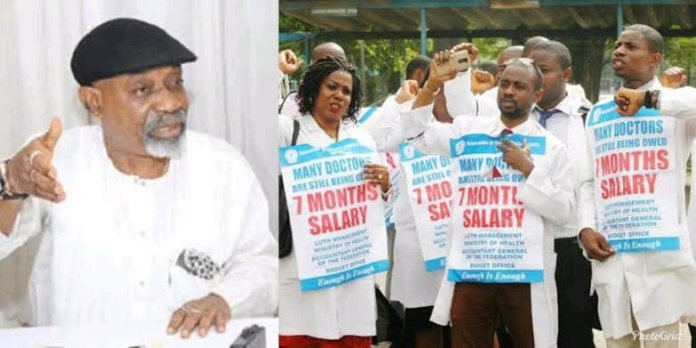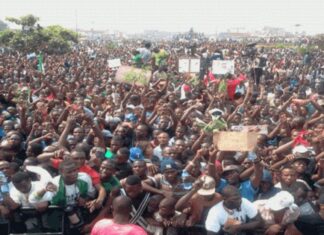Resident doctors have been on strike to demand regular salaries and an increase in allowances since 2 August. This is in line with a collective agreement reached with the federal government in April, but which the government has failed to implement. There are several teaching hospitals where resident doctors have not been paid for between eight and nineteen months!
The federal government is notorious for going back on collective agreements with trade unions. That is why there have been series of strikes over the past few years, particularly in the health and education sectors.
Doctors and other health workers have been on the frontline of the fight against COVID-19. Despite being poorly paid, they have been doing the best they can under the most challenging working conditions. Public hospitals are understaffed and without adequate facilities, equipment, and medical supplies. But Maj Gen Buhari (retd.) and his cohorts do not care.
Government officials and rich businesspeople can always access the best healthcare services overseas and in the expensive private hospitals in major cities across the country. In fact, the shameless head of state traveled during the ongoing strike for medical attention in Britain.
Background to the resident doctors’ strike
A wave of strikes swept through the health sector last year. Nurses, doctors, and other health workers downed tools and, in some cases, took them to the streets. They were protesting poor wages and lack of the necessary personal protective equipment (PPE) as they cared for COVID-19 patients.
During this period, the National Association of Resident Doctors (NARD) went on strike twice. They lamented the lack of adequate payment and life insurance during such a serious pandemic that put their lives at risk. They demanded improved working conditions and an upward review of their hazard allowance, which is a laughable N5,000 for some of their members.
During its first strike last year, which was in June, NARD directed its members treating COVID-19 patients to continue working. This was an expression of its concern, despite the government’s anti-workers disposition.
But the government did not budge or take their demands seriously. The association then organized a second strike in September. All NARD members were asked to “down tools.” It was a total strike. However, NARD called off the strike after two weeks, when the federal government said it needed some time to address their demands.
The federal government was, however not being sincere. It had no intention to do this. It took yet another strike, this time in April 2021, before it even agreed to sign a Memorandum of Understanding to implement the resident doctors’ demands. Four months after, no steps had been taken to implement the provisions of this collective agreement. This is what sparked the current strike action.
Public health system in shambles; poor masses bear the brunt
The insensitivity of the federal government is almost unbelievable. The country is witnessing its most severe wave of the COVID-19 pandemic, driven by the virulent Delta variant. If it had any concern for the Nigerian masses, it would be making sure that the legitimate concerns of doctors, nurses, and all other health workers are promptly attended to, so that they can help save lives.
Nigeria already has a shortage of doctors and health workers. The World Health Organization recommends that there should be one doctor per 600 people in a country. This means that we need about 350,000 doctors in Nigeria. But the total number of registered Nigerian doctors is just 74,543. And only 42,000 are practicing in the country! 16,000 of these are resident doctors.
Thousands of Nigerian doctors migrate in search of better pay and working conditions. At least 7,875 doctors are practicing in Britain alone, according to the British General Medical Council. And the number keeps increasing.
A few days ago, we saw doctors swarm at Sheraton hotel Abuja to apply for work in Saudi Arabia. This included specialists, medical consultants, and professors who have been training younger doctors for decades. The adverse implication of this cannot be overemphasized.
Yet, Dr Chris Ngige, the foolish medical doctor who is the country’s minister of labor, thinks that the country has surplus doctors. This kind of warped mindset informs the APC regime’s actions.
Instead of meeting the doctors’ demands, it threatened them with “no work, no pay.” The doctors refused to succumb to this blackmail. They pointed out that those in power ad top bureaucrats in the ministries, departments, and agencies “that are yet to carry out their duties in ensuring these issues are addressed” should be the ones to be punished.
The NARD president, Dr. Uyilawa Okhuaihesuyi pointed out how ridiculous it is for doctors to be paid N5,000 as hazard allowance while members of the House of Representatives and Senators receive N1.2 million and N3 million “or more” respectively as hardship allowance.
Some of the 52 federal health institutions (FHIs) have started implementing this illegitimate “no work, no pay” policy. But the doctors remained steadfast in pursuit of the strike. The federal government then tried to use any one of its old tricks, using its courts.
It first used a fake non-governmental organization, a so-called “Rights for All International,” which asked the court to order resident doctors back to work. The court did not grant that request. The federal government then headed to the National Industrial Court (NICN) for the same purpose.
The industrial court’s response was a tricky one. It did not outrightly grant the government’s request. But it asked both sides to halt hostilities. This is subtle support for the government. The NICN has consistently been on the government’s side as a tool for taking the wind out of the sails of strikes and workers’ protests over the years.
The Nigeria Medical Association stepped into the industrial conflict, helping to navigate negotiations between the resident doctors and the federal government. And a new Memorandum of Understanding has been signed. But the doctors want more than just another MoU signing ceremony.
As Prof. Innocent Ujah, the NMA president, noted, “the fear by the resident doctors is that once they call off the strike, the Federal Government may renege as had been the situation in the past.” This fear is clearly justified.
It is unlikely that this will be the last strike in the health sector. There are fundamental problems that affect doctors and all other health workers. They are some of the most underpaid in the world. Their working conditions are terrible. And the federal government often reneges on collective agreements.
These are part of the broader problem of gross underfunding of health and social care in the country. Nigeria’s current public spending on health care is 3.89% of the country’s gross domestic product (GDP). This is far below the African average (6.1% OF GDP), not to mention the average spent on health in advanced capitalist countries (9.5% of GDP).
This translates into poor health care services: public hospitals with shortages of beds and without drugs or needed medical supplies; 917 women dying from childbirth out of every 100,000 live births every year; 857,899 children younger than five years dying due to poor health services and poverty, every year; 81,640 deaths from malaria, a curable illness, every year; and overworked, underpaid, and demotivated medical and health workers.
Need for “Right to Health” mass movement & the challenge of workers’ unity
The struggles of doctors and other health workers is, thus, implicitly a struggle in the collective interest of poor working-class people. The rich few in government and business are not bothered because they hardly rely on the public health system, which is in shambles.
The unions and professional associations in the sector need to explicitly expand their struggle beyond the legitimate demands for salary increases to build system-changing power. We need to build a people’s health movement of the communities and radical civil society movement for quality public healthcare for all. This can be built only with the health sector unions and associations at the center of such an effort.
But first, the unions have to establish stronger all-inclusive solidarity. At the moment, there are schisms between the doctors and other unions and professional associations in the sector.
These unions and associations which include the Medical and Health Workers’ Union of Nigeria (MHWUN), National Association of Nigeria Nurses and Midwives (NANNM), National Union of Allied Health Professionals (NUAHP), National Union of Non-Academic Staff (NASU), and the Senior Staff Union of University Teaching Hospitals (SSATHURAI) who are collectively organized as the Joint Health Sector Unions (JOHESU).
We know that the line of division between the doctors and JOHESU will not disappear in a day or simply in response to empty slogans for unity from outside the sector. And we also know that there have been efforts to bridge this divide, which stumbled along the way.
It is, however in our collective interest to seize the bull by the horns now to address this pressing issue. Healthcare workers can win more if all the unions and associations in the sector unite and fight. They can also lead the struggle of working-class people, as a mass movement, to force the government to invest in much better public health care delivery for the poor masses.
by Baba AYE









